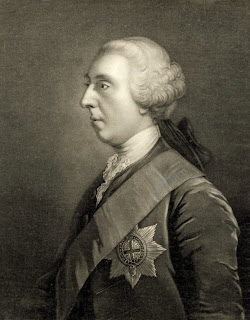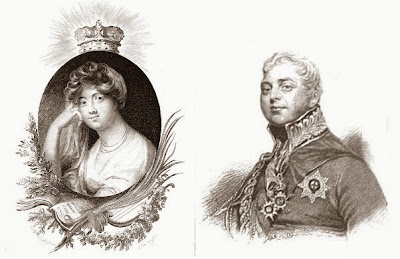 |
| Maria Waldegrave, later Duchess of Gloucester from Letters of Horace Walpole to Sir Horace Mann Vol 4 (1844) |
Maria, Duchess of Gloucester (baptized 10 July 1736 - 22 August 1807), was the beautiful but illegitimate daughter of Sir Edward Walpole. She married first the 2nd Earl Waldegrave and then William Henry, 1st Duke of Gloucester, younger brother of George III who disapproved of their marriage.
Family background
Family background
Maria Walpole was baptized on 10 July 1736 at St James’, Westminster. Her father was Sir Edward Walpole, MP, a younger son of Sir Robert Walpole, Prime Minister, and her mother was Dorothy Clement, who had been apprenticed to a Covent Garden milliner. Although her parents were not married, Maria was brought up in her father’s household with her sisters, Laura and Charlotte, and treated as if she was his legitimate offspring. Her aunt, Jane Clement, was also part of the household.
Maria’s uncle, Horace Walpole, admired her beauty and took it upon himself to launch her into society:
It is the second, Maria, who is beauty itself! Her face, bloom, eyes, hair, teeth, and person are all perfect. You may imagine how charming she is, when her only fault, if one must find one, is, that her face is rather too round. She has a great deal of wit and vivacity, with perfect modesty.1
 |
| James Waldegrave, 2nd Earl Waldegrave Print by J McArdell after Sir Joshua Reynolds (1762) © British Museum |
On 15 May 1759, Maria married James Waldegrave, 2nd Earl Waldegrave, a Lord of the Bedchamber to George II and governor to the future George III, at her father’s house in Pall Mall. Horace Walpole wrote:
For character and credit, he is the first match in England – for beauty, I think she is.2
Maria was in a white silver gown, with a hat very much pulled over her face; what one could see of it was handsomer than ever; a cold maiden blush gave her the sweetest delicacy in the world.3
The Earl was more than twenty years older than Maria, but the marriage was deemed a success. They had three beautiful daughters: Elizabeth Laura (1760), Charlotte Maria (1761) and Anna Horatia (1762).
 |
| Lady Maria Waldegrave, Laura Viscountess Chewton and Lady Horatia Waldegrave from The Letters of Horace Walpole ed P Cunningham Vol 5 (1859) |
Sadly, the Earl died suddenly of smallpox in Albemarle Street, London, on 8 April 1763. Maria was distraught. For a while, she thought she was carrying his child, but eventually she had to admit that it was not so and the estates went to the Earl’s brother, leaving Maria with a comparatively meagre allowance of £1,000 a year.
A second marriage
Horace Walpole had high hopes that Maria would make a second advantageous marriage:
A second marriage
Horace Walpole had high hopes that Maria would make a second advantageous marriage:
She is allowed the handsomest woman in England; as she is so young, she may find as great a match and a younger lover — but she never can find another Lord Waldegrave!4On 6 September 1766, Maria married William, 1st Duke of Gloucester, at his house in Pall Mall. The ceremony was performed in secret by her chaplain, Dr Morton, and there were no witnesses.
 |
| William Henry, Duke of Gloucester by Richard Earlom after Hugh Douglas Hamilton pubd by Robert Sayer (1771) © British Museum |
In 1768, the Duke bought Maria a house at St Leonard’s Hill, near Cranborne Lodge, the house that went with his role as Ranger of Cranborne Chase.
Banned from the Court
George III thought that Maria was a bad influence on his brother and refused to believe the rumours that he had married her. He granted her a pension of £5,000 a year from the Irish revenues, and sent the Duke abroad on diplomatic visits in an effort to wean him from her company.
When Maria became pregnant, the Duke finally confessed his marriage in a letter to the King. As the ceremony h without witnesses and Maria’s chaplain had since died, George III launched an enquiry into the legitimacy of the marriage, just days before her baby was born. The King was forced to accept his brother’s marriage, but he felt betrayed over his secrecy and banned William and Maria and their family from the royal presence.
Family life
Maria had three children by her second marriage: Sophia Matilda (1773), Caroline Augusta Maria (1774) who died before her first birthday, and William Frederick (1776).
Banned from the Court
George III thought that Maria was a bad influence on his brother and refused to believe the rumours that he had married her. He granted her a pension of £5,000 a year from the Irish revenues, and sent the Duke abroad on diplomatic visits in an effort to wean him from her company.
When Maria became pregnant, the Duke finally confessed his marriage in a letter to the King. As the ceremony h without witnesses and Maria’s chaplain had since died, George III launched an enquiry into the legitimacy of the marriage, just days before her baby was born. The King was forced to accept his brother’s marriage, but he felt betrayed over his secrecy and banned William and Maria and their family from the royal presence.
Family life
Maria had three children by her second marriage: Sophia Matilda (1773), Caroline Augusta Maria (1774) who died before her first birthday, and William Frederick (1776).
In time, the King became reconciled to his brother William, but not to Maria. William’s own relationship with Maria deteriorated and he started an affair with Lady Almeria Carpenter, Maria’s lady in waiting. Sometimes he denied Maria access to her children, but despite their difficulties, they continued to keep a joint household and Lady Almeria never completely eclipsed Maria.
Religious commitment
During the latter years of her life, Maria’s religious commitment increased. Her eldest daughter Laura, who had married her cousin and become Countess Waldegrave, lost first her husband and then her eldest son. The bluestocking evangelical Hannah More was a correspondent of Maria’s uncle Horace Walpole and she offered religious consolation to the grief-stricken Countess and her mother. Although Maria did not fully embrace evangelicalism, she supported More’s Cheap Repository Tracts and welcomed Wilberforce’s Practical View.
Religious commitment
During the latter years of her life, Maria’s religious commitment increased. Her eldest daughter Laura, who had married her cousin and become Countess Waldegrave, lost first her husband and then her eldest son. The bluestocking evangelical Hannah More was a correspondent of Maria’s uncle Horace Walpole and she offered religious consolation to the grief-stricken Countess and her mother. Although Maria did not fully embrace evangelicalism, she supported More’s Cheap Repository Tracts and welcomed Wilberforce’s Practical View.
The last few years
For the sake of economy and William’s health, the Duke and Duchess lived much of their married life on the continent. William suffered from several bouts of a debilitating illness similar to that suffered by his brother George III and he died on 25 August 1805. The King was kind to Maria after William’s death, for the sake of their children.
After the Duke’s death, Maria lived at Oxford Lodge, Brompton Road, London, where she died on 22 August 1807. She was buried at St George’s Chapel, Windsor, on 31 August.
After the Duke’s death, Maria lived at Oxford Lodge, Brompton Road, London, where she died on 22 August 1807. She was buried at St George’s Chapel, Windsor, on 31 August.
Rachel Knowles writes clean/Christian Regency era romance and historical non-fiction. She has been sharing her research on this blog since 2011. Rachel lives in the beautiful Georgian seaside town of Weymouth, Dorset, on the south coast of England, with her husband, Andrew.
Find out more about Rachel's books and sign up for her newsletter here.If you have enjoyed this blog and want to encourage me and help me to keep making my research freely available, please buy me a virtual cup of coffee by clicking the button below.
Notes
(1) In a letter from Horace Walpole to Sir Horace Mann (9 Sept 1758) about his brother’s second daughter - from The Letters of Horace Walpole, Earl of Orford, Vol 3 of 6 (1840).
(1) In a letter from Horace Walpole to Sir Horace Mann (9 Sept 1758) about his brother’s second daughter - from The Letters of Horace Walpole, Earl of Orford, Vol 3 of 6 (1840).
(2) In a letter from Horace Walpole to Sir Horace Mann (11 Apr 1759) - from The Letters of Horace Walpole, Earl of Orford, Vol 3 of 6 (1840).
(3) In a letter from Horace Walpole to George Montagu (16 May 1759) from The Letters of Horace Walpole, Earl of Orford, Vol 3 of 6 (1840).(4) In a letter from Horace Walpole to Sir Horace Mann (10 Apr 1763) - from The Letters of Horace Walpole, ed P Cunningham Vol 4 of 8 (1857).
Sources used include:
Hibbert, Christopher, George III (1998, Viking, Great Britain)
Kilburn, Matthew, William Henry, Prince, first Duke of Gloucester and Edinburgh (1743-1805) Oxford Dictionary of National Biography (Oxford University Press, 2004; online edn Jan 2008, accessed 28 Oct 2013)
Stott, Anne, Hannah More, The First Victorian (2003)
Walpole, Horace, The Letters of Horace Walpole, Earl of Orford, in six volumes (1840)
Walpole, Horace, Letters of Horace Walpole to Sir Horace Mann in four volumes (1844)
Walpole, Horace, The Letters of Horace Walpole, edited by P Cunningham, in eight volumes (1857)




No comments:
New comments are not allowed.